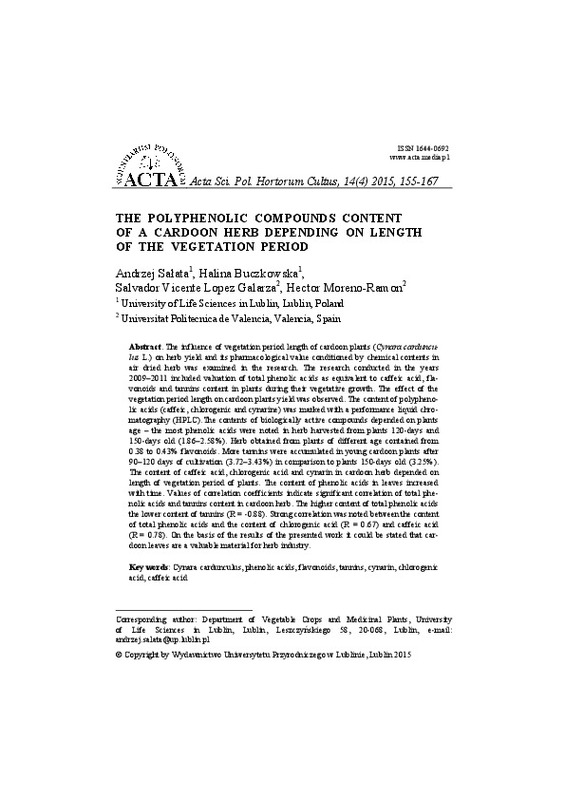JavaScript is disabled for your browser. Some features of this site may not work without it.
Buscar en RiuNet
Listar
Mi cuenta
Estadísticas
Ayuda RiuNet
Admin. UPV
The polyphenolic compounds content of cardoon herb depending on length of the vegetation period
Mostrar el registro sencillo del ítem
Ficheros en el ítem
| dc.contributor.author | Salata, Andrzej
|
es_ES |
| dc.contributor.author | Buczkowska, Halina
|
es_ES |
| dc.contributor.author | López Galarza, Salvador Vicente
|
es_ES |
| dc.contributor.author | Moreno Ramón, Héctor
|
es_ES |
| dc.date.accessioned | 2017-03-14T07:38:00Z | |
| dc.date.available | 2017-03-14T07:38:00Z | |
| dc.date.issued | 2015 | |
| dc.identifier.issn | 1644-0692 | |
| dc.identifier.uri | http://hdl.handle.net/10251/78715 | |
| dc.description.abstract | [EN] The influence of vegetation period length of cardoon plants (Cynara cardunculus L.) on herb yield and its pharmacological value conditioned by chemical contents in air dried herb was examined in the research. The research conducted in the years 2009-2011 included valuation of total phenolic acids as equivalent to caffeic acid, flavonoids and tannins content in plants during their vegetative growth. The effect of the vegetation period length on cardoon plants yield was observed. The content of polyphenolic acids (caffeic, chlorogenic and cynarine) was marked with a performance liquid aromatography (HPLC). The contents of biologically active compounds depended on plants age the most phenolic acids were noted in herb harvested from plants 120-days and 150-days old (1.86-2.58%). Herb obtained from plants of different age contained from 0.38 to 0.43% flavonoids. More tannins were accumulated in young cardoon plants after 90-120 days of cultivation (3.72-3.43%) in comparison to plants 150-days old (3.25%). The content of caffeic acid, chlorogenic acid and cynarin in cardoon herb depended on length of vegetation period of plants. The content of phenolic acids in leaves increased with time. Values of correlation coefficients indicate significant correlation of total phenolic acids and tannins content in cardoon herb. The higher content of total phenolic acids the lower content of tannins (R = -0.88). Strong correlation was noted between the content of total phenolic acids and the content of chlorogenic acid (R = 0.67) and caffeic acid (R = 0.78). On the basis of the results of the presented work it could be stated that cardoon leaves are a valuable material for herb industry. | es_ES |
| dc.description.abstract | [PL] W pracy badano wpływ długości okresu wegetacji roślin karda (Cynara cardunculus L.) na jego wartość farmakologiczną, uwarunkowaną składem chemicznym surowca. Badania przeprowadzono w latach 2009–2011, oceniając zawartość kwasów fenolowych w przeliczeniu na kwas kawowy oraz flawonoidów i garbników w zależności od fazy rozwojowej roślin. Zawartość kwasów polifenolowych (kawowego, chlorogenowego i cynaryny) oznaczano z wykorzystaniem HPLC. Zawartość substancji biologicznie czynnych zależała od wieku roślin – największą ilość fenolokwasów stwierdzono w zielu zebranym z roślin 120- i 150-dniowych (1,86–2,58%). Ziele zebrane z roślin w różnym wieku zawierało 0,38–0,43% flawonoidów. Więcej garbników zgromadziły młodsze rośliny karda po 90–120 dniach uprawy (3,72–3,43%) w porównaniu z roślinami 150-dniowymi (3,25%). Zawartość kwasu kawowego, chlorogenowego i cynaryny w zielu karda zależała od długości okresu wegetacji roślin. Wraz z jego wydłużaniem zwiększała się zawartość tych kwasów fenolowych w liściach. Wartości współczynników korelacji wskazują na istotnie wysoką współzależność zawartości fenolokwasów ogółem i garbników w zielu karda. Większej zawartości fenolokwasów ogółem towarzyszy mniejsza zawartość garbników (R = -0,88). Silną korelację odnotowano pomiędzy zawartością fenolokwasów ogółem a zawartością kwasu chlorogenowego (R = 0,67) i kwasu kawowego (R = 0,78). Na podstawie uzyskanych wyników tej pracy można stwierdzić, że liście karda stanowią cenny surowiec dla przemysłu zielarskiego. | es_ES |
| dc.language | Inglés | es_ES |
| dc.relation.ispartof | Acta Scientiarum Polonorum-Hortorum Cultus | es_ES |
| dc.rights | Reserva de todos los derechos | es_ES |
| dc.subject | Cynara cardunculus | es_ES |
| dc.subject | Phenolic acids | es_ES |
| dc.subject | Flavonoids | es_ES |
| dc.subject | Tannins | es_ES |
| dc.subject | Cynarin | es_ES |
| dc.subject | Chlorogenic acid | es_ES |
| dc.subject | Caffeic acid | es_ES |
| dc.subject.classification | PRODUCCION VEGETAL | es_ES |
| dc.title | The polyphenolic compounds content of cardoon herb depending on length of the vegetation period | es_ES |
| dc.type | Artículo | es_ES |
| dc.rights.accessRights | Abierto | es_ES |
| dc.contributor.affiliation | Universitat Politècnica de València. Escuela Técnica Superior de Ingeniería Agronómica y del Medio Natural - Escola Tècnica Superior d'Enginyeria Agronòmica i del Medi Natural | es_ES |
| dc.description.bibliographicCitation | Salata, A.; Buczkowska, H.; López Galarza, SV.; Moreno Ramón, H. (2015). The polyphenolic compounds content of cardoon herb depending on length of the vegetation period. Acta Scientiarum Polonorum-Hortorum Cultus. 14(4):155-167. http://hdl.handle.net/10251/78715 | es_ES |
| dc.description.accrualMethod | S | es_ES |
| dc.relation.publisherversion | http://www.acta.media.pl/pl/main.php?&lang=en | es_ES |
| dc.description.upvformatpinicio | 155 | es_ES |
| dc.description.upvformatpfin | 167 | es_ES |
| dc.type.version | info:eu-repo/semantics/publishedVersion | es_ES |
| dc.description.volume | 14 | es_ES |
| dc.description.issue | 4 | es_ES |
| dc.relation.senia | 293022 | es_ES |






